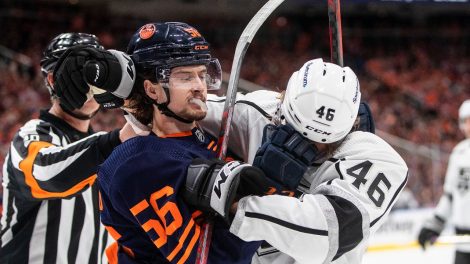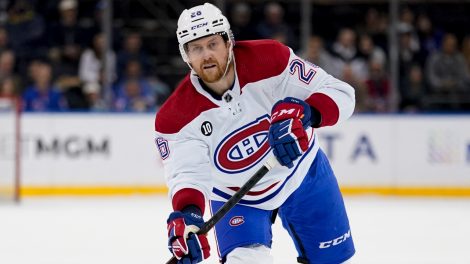TORONTO — By trading David Clarkson to the Columbus Blue Jackets, the Toronto Maple Leafs got out from under the weight of their worst contract as they embark on a rebuilding project.
The Leafs sent Clarkson and his US$5.25-million cap hit for five more seasons to the Columbus Blue Jackets for injured winger Nathan Horton, who has a similar salary and term but could cost nothing on the cap while on long-term injured reserve.
"We get a player that if he could ever come back is an elite player," general manager Dave Nonis said Thursday night. "In the event he can’t, we created some cap space."
Limited to just 36 games with Columbus and none this season because of back problems since signing there in the summer of 2013, the 29-year-old Horton may never play again. But that would simply allow the Leafs to use his $5.3 million salary elsewhere.
The return for Clarkson was almost inconsequential compared to dealing the underachieving right-winger and his albatross contract. After inking a $36.75-million, seven-year contract on July 5, 2013, Clarkson had just 15 goals and 11 assists in 118 games with the Leafs.
"I know he did whatever he could to be a successful Maple Leaf, and I don’t blame him for anything that happened here," Nonis said. "He showed flashes. There were moments where we had the David that we hoped to have. But overall it was probably disappointing for both sides, and I do believe he’s going to go there and play well."
Clarkson was a healthy scratch for two straight games earlier this month, and given the structure of his contract, the Leafs seemingly had little recourse. A buyout would hurt the long-term future more than help it, and because of a no-movement clause, the 30-year-old could not be put on waivers to go to the minors and had to approve any trade.
Approached by Nonis to go to the Blue Jackets, Clarkson did just that. He goes to a Blue Jackets team that is not in the playoff hunt but figures to be back in it next season, and general manager Jarmo Kekalainen hopes the one-time 30-goal scorer is a big part of that.
"He’ll fit out needs and our group perfectly," Kekalainen told reporters at a news conference in Columbus. "We now have a piece of the puzzle in place."
The deal makes sense for the more frugal Blue Jackets because they’ll be paying Clarkson to play instead of Horton not to play. No salary was retained in the deal, so the two players with eerily similar contracts but very different situations were able to be swapped in a deal that came together fairly quickly, according to Nonis.
Having more than $5 million to spend moving forward is a major advantage for the Leafs, who don’t mind the financial ramifications of paying Horton. But if the rebuild goes into full gear, they might not spend up to the limit.
"Cap space is available to us. It doesn’t mean that you have to use it," Nonis said. "That’s the one thing I think that’s important for us to look at, as well. It’s available space as we move forward and allows us to possibly take advantage of opportunities as the summer progresses or even the next year in the event that Nathan can’t play."
This is the third major trade in the past couple of weeks for the Leafs, who sent defenceman Cody Franson and forward Mike Santorelli to Nashville for a first-round pick, prospect Brendan Leipsic and veteran Olli Jokinen on Feb. 15 and forward Daniel Winnik to Pittsburgh on Wednesday for second- and fourth-round picks and pending free-agent centre Zach Sill.
More moves could be coming before Monday’s 3 p.m. trade deadline, but Nonis didn’t guarantee that.
"Right now I’d tell you that we’re not close on anything else, but Monday’s still a little ways away," he said.
Leafs players found out about the trade in a pre-game meeting before facing the Philadelphia Flyers.
"We knew obviously he wasn’t there, so we kind of knew something was up," goaltender Jonathan Bernier said. "Obviously it’s a sad day to see Clarky leave. But if it’s better for the team then I think as a group we’ll take that."










